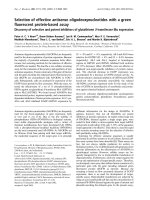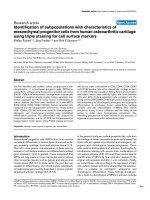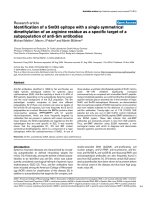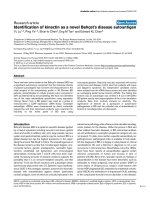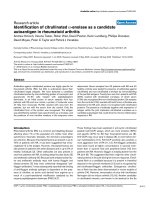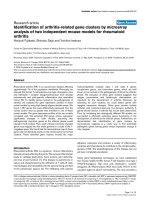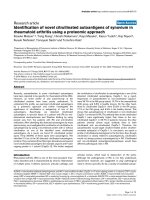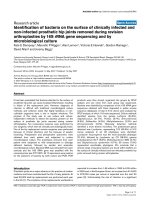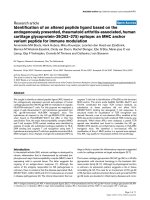Báo cáo y học: " Identification of NCAM that interacts with the PHE-CoV spike protein" pdf
Bạn đang xem bản rút gọn của tài liệu. Xem và tải ngay bản đầy đủ của tài liệu tại đây (995.02 KB, 11 trang )
RESEARC H Open Access
Identification of NCAM that interacts with the
PHE-CoV spike protein
Wei Gao
1,3†
, Wenqi He
1†
, Kui Zhao
1
, Huijun Lu
2
, Wenzhi Ren
3
, Chongtao Du
1
, Keyan Chen
1
, Yungang Lan
1
,
Deguang Song
1*
, Feng Gao
1*
Abstract
Background: The spike proteins of coronaviruses associate with cellular molecules to mediate infection of their
target cells. The characterization of cellular proteins required for virus infection is essential for understanding viral
life cycles and may provide cellular targets for antiviral therapies.
Results: We identified Neural Cell Adhesion Molecule (NCAM) as a novel interacting partner of the PHE-Co V S
protein. A T7 phage display cDNA library from N2a cells was constructed, and the library was screened with the
soluble PHE-CoV S glycoproteins. We used a coimmunoprecipitation assay to show that only the NCAM was a
binding partner of spike protein. We found that a soluble form of anti-NCAM antibody blocked association of
the PHE-CoV with N2a cells. Furthermore, double-stranded siRNA targeted against NCAM inhibited PHE-CoV
infection.
Conclusions: A novel interaction was identified between NCAM and spike protein and this association is critical
during PHE-CoV infection.
Background
Porcine hemagglutinating encephalomyelitis coronavirus
(PHE-CoV) is a member of the Coronaviridae family,
which causes porcine encephalomyelitis [1]. The
mechanisms by which PHE-CoV infects cells and causes
disease are not well c haracterized, nor are the factors
known which determine the host and tissue specificity.
The cellular receptor which is a crucial determinant of
the tropism of several viruses, is not known in the case
of PHE-CoV.
The spike glycoprotein of coronavirus is a major
determinant of neurovirulence [2-5]. The coronavirus
spi ke glycoprotein is responsible for viral attachment to
the cellul ar receptor and fusion of t he viral and cellular
memb ranes, resulting in virus entry [4]. Several types of
receptors for coronavirus have bee n previously identified
[6]. The murine carcinoembryo nic antigen cell adhesion
molecule 1 (CEACA M1) and related muri ne glycopro-
teins in the carcinoembryonic antigen family of the Ig
superfamily are the receptors for the murine coronavirus
mous e hepatitis virus [4]. The aminop eptidase N (APN)
glycoproteins are the receptors for human coronavirus
229E (HCoV-229E), the transmissible gastroenteritis
virus of swine, and the feline coronavirus of genetic
group 1 [7-10].
PHE-CoV has a strong tropism for the central nervous
system (CNS) [11]. The virus spreads via peripheral
nerves to the CNS. PHE-CoV propagates mainly in the
CNS, and nerve cells are a main t arget for virus replic a-
tion [12]. The molecular mechanisms and specific pro-
teinsinvolvedinadhesionofPHE-CoVtohostcells
have not yet been elucidated.
In this work, we discovered that the PHE-CoV S pro-
tein interacted with NCAM by screening a T7 phage
cDNA library from Neuro-2a (N2a) cells. It is necessary
to investigate these interactions with host-cell proteins,
as discovering these interactionsmaybehelpfulinthe
identification of host proteins participating in important
stages of the virus life cycle, such as virus entry, virion
morphogenesis, and virion release.Inaddition,estab-
lished protein contacts could serve as targets for anti-
viral chemotherapy.
* Correspondence: ;
† Contributed equally
1
College of Animal Science and Veterinary Medicine, Jilin University,
Changchun 130062, PR China
Full list of author information is available at the end of the article
Gao et al. Virology Journal 2010, 7:254
/>© 2010 Gao et al; licensee BioMed Central L td. This is an Open Access article distributed under the terms of the Creative Commons
Attribution License ( which permits unrestricted use, distribution, and reproduction in
any medium, provided the original work is properly cited.
Methods
Animals
Specific pathogen-free lines of piglets were purchased
from the Centre for Medicine Animal Research (Jilin,
China). Animal procurement and transportation into the
HEPA-ventilated caging systems and performance of the
experimental-challenge tests were performed in accor-
dance with the guidelines for animal experimentation of
Jilin University.
Viruses and cell culture
The 67N strain of PHE-CoV [13] was propagate d and
assayed by the plaque method in N2a cell culture, as
describedpreviously[14],andthetitreswereexpressed
as plaque-forming units (PFU). The cell lines were
obtained from the American Type Culture Collection
(ATCC), N2a (ATCC CCL-131) and 293T (ATCC CRL-
11268). These cells were maintained in Dulbecco’ s
modified Eagle’ s medium (Invitrogen, Carlsbad, CA)
supplemented with 10% cosmic calf serum (HyClone,
Logan, UT) and 2 m M L-gluta mine. All o f the cell
cultures were maintained at 37°C in 5% CO
2
.
Protein production
The recombinant S protein of PHE-CoV was obtained
using a Pichia pastoris yeast expression system. The S
gene was subcloned by PCR. The forward primer for the
Sgene(5’ -CGGAATTCGTGCCATCTATTAGCTCT-
GAAGT-3’) and the reverse primer for the S gene (5’-
TTGCGGCCGCAAGTATGCCCTGGCCTGTAATG-3’)
introduced EcoRI and NotI sites, respecti vely. Follow ing
gel purification, using the QIAquick gel extraction kit
(Qiagen, Valencia, CA), the purified PCR products were
ligated into the EcoRI and NotI sites of the pPICZaA
vector (Invitrogen, San Diego, CA), yielding pPICZaAS.
GS115 yeast cells, transformed with pPICZaAS (Invitro-
gen, San Diego, CA), were grown at 30°C in 100 ml
liquid Buffered Methanol Complex Medium (BMMY)
(Invitrogen, San Diego, CA) with 0.1 mg/ml Zeocine
(Invitrogen, San Diego, CA). Production of the His6-
tagged fusion S protein was induced with 1% methanol.
After 5 d, the protein was collected from the superna-
tant. The His6-tagged recombinant S protein was puri-
fied by nickel affinity chromatography with the HisTrap
HP column (Amersham Biosciences AB, Uppsala,
Sweden).
Preparation of the T7 phage display library from N2a
cells
Total RNA from the N2a cells was extracted using stan-
dard methodology, while mRNA was purified using the
poly (A) Quick mRNA Isolation Kit (Promega, South-
ampton, UK). A cDNA library was constructed with 10
μg mRNA, following the manufacturer’s instructions for
the OrientExpress Ra ndom Primer cDNA Synthesis kit
(Novagen, Madison, W I), with some modifications. The
first and second strand cDNA syntheses are simple reac-
tions that are carried out sequentially in the presence of
5-methyl dCTP, which protects any internal E coR I and
Hind III restriction sites from digestion. T he cDNA was
treated with T4 DNA polymerase to blunt the ends, and
EcoR I/Hind III Directional Linker was added at the
end. Following, the cDNA fragment s were digested with
EcoRI and HindIII. The Mi ni Column Fractionation Kit
(Novagen, Madison, WI) is used for rapid and effective
size fractionation of DNA and remo val of sm all mole-
cules (< 300 bp) from DNA solutions by gel filtration.
The cDNA fragments were ligated to t he arms of T7
Select 10-3b and packaged in vitro using a T7 packaging
extract (Novagen, Madison, WI), according to the man-
ufacturer’s directions. The packaged phage were ampli-
fied in liquid media with the host Escherichia coli
BLT5403.
Panning
In order to screen the clones that display the adhesion
protein, the c DNA library from N2a cells was panned
with the S protein. The 96-well plates were coated with
200 μl of the purified S protein (2 mg/ml) in coating
buffer (50 mM NaHCO
3
pH 9.6) overnight at 4°C. Non-
specific sites were blocked with 5% bovine serum albu-
min for 1 h at 37 °C, and a 100 μlaliquotoftheT7
phage display library (containing 6.4 × 10
10
PFU/ml)
was added to the wells and incubated for 2 h at 37°C.
Following this, the wells were washed five times with
PBST (phosphate-buffered saline containing 0.1% [v/v]
Tween-20) to d iscard any u nbound phages. The bound
phages were eluted with 200 μlofT7elutionbuffer
(TBS in 1% sodium dodecyl sulfate [SDS]) and amplified
by infecting Escherichia coli BL T5403 [15]. The ampli-
fied phages were then subjected to another four rounds
of panning as described above, to enrich the clones that
were highly specific for the S protein of PHE-CoV.
Sequence analysis
After five rounds of panni ng, the final en riched specific
clones were plated and single pure plaques were iso-
lated. The cDNA insert s in these plaques were amplified
by PCR using primers (T7 S elect Up primer: 5’ -
GGAGCTGTCGTATTCCAGTC-3’ ; T7 Select Down
primer: 5’-AACCCCTCAAGACCCGTTTA-3’ )flanking
the inserts. Each PCR consisted of 30 cycles of dena-
turation at 94°C for 1 min, annealing at 50°C for 1 min,
and extension at 72°C for 1 min. The reaction also
included an initial denaturation step at 94°C for 5 min
and a final extension step at 72°C for 7 min. After PCR
Gao et al. Virology Journal 2010, 7:254
/>Page 2 of 11
amplification, the products were puri fied by Qiaquick
columns (Qiagen, Hilden, Germany) and were then
sequenced.
The nucleotide sequence of the protein that was most
predominantly recognized by the S protein of PHE-CoV
was a hypothetical gene of N2a cells i.
nlm.nih.gov/blast.
Transfections and co-immunoprecipitation
The PHE-CoV 67N strain did not infect the 293T cell
line. To investigate the interact ions between the PHE-
CoV 67N strain and the chimeric protein, 293T cells
were transfected with the pcDNA3.1 (+) (Invitrogen,
Carlsbad, CA) expression plasmid containing the chi-
meric gene, using Lipofectamine 2000 (Invitrogen, Carls-
bad, CA). The trans fections were performed fo llowing
the manufacturers’ protocols [16,17]. After 24 h, the
cells were replated in selective media containing 50-100
μg/ml ampicillin [18], and single ampicillin-resistant
clones were selected.
For co-immunoprecipitation, cells were lysed in 500 μl
of radioimmune precipitation buffer (150 mm NaCl, 5
mg/ml sodium deoxycholate, 50 mm Tris-HCl, pH 7.5,
1% Nonidet P-40, 0.1% SDS) supplemen ted with freshly
added p rotease inhibitors. Afte r rotating for 1 h at 4° C,
cell lysates were cleared by centrifugation at 8000 × g
for 10 min at 4°C. The 100-ml aliquot of lysate was
incubated with 3 ml of glutathione-Sepharose beads
conjugated with His6-tagged fusion S (6 mg). Cell
lysate s were electrophoresed through 12% sodium dode-
cyl sulfate-polyacrylamide gels and transferred to polyvi-
nylidene difluoride membranes. The blots were blocked
at room temperature for 3 h with 3% BSA in PBS con-
taining Tween 20 (0.05%) and then incubated overnight
with a 1:2,000 dilution of the rabbit anti-S protein anti-
body. The blot were washed again and exposed to films
[19].
Flow Cytometry
We investigated whether a soluble form of the rabbit
anti-NCAM antibody (Santa Cruz, California, USA,
CATALOG: SC-10735) could inhibit PHE-CoV b inding
to N2a cells. The anti-NCAM antibody was diluted and
added to N2a cells. The cells were incubated with 100
μl of soluble anti-NCAM antibody (10-25 μg/ml) for 1 h
at 37°C. The controls included cells with goat IgG
(1:1000) (Maixin, Fuzhou, China). Following this, the
wells were washed five times with PBS (phosphate-buf-
fered saline). After 2 hours, the PHE-CoV 67N strain
(diluted to yield 20 to 40 plaques/well in 20 μl) was
added to N2a cells that had been grown at a plating
density of 10
5
cells per well in 24-well plates. After a
48-h infection, PHE- CoV binding was detected with the
Rabbit PHE-CoV antiserum. The N2a cells were coated
with 20 μl of rabbit anti-PHE-CoV antiserum at 1:1,00 0
per well for 1 h at 37°C. The cells were washed three
times in PBS (pH7.4). Fluorescein (FITC)-conjugat ed
goat anti-rabbit IgG (H+L) (Jackson ImmunoResearch
Laboratory, West Grove, PA) was added to the N2a cell
mixtures for 30 min. After 48 hours, the samples were
analyzed on a BD FACSAria flow cytometer [6].
Transfection of siRNAs and PHE-CoV infection
Double-stranded siRNA were designed based on the
NCAM gene sequence to various regions of the genome
using the Ambion siRNA Design tool http://www.
ambion.com. Sequences were designed using (NN) N19
nt (where N is any nucleotide) and a GC content of less
than 50%. The siRNAs targeted against the NCAM gene
were synthesized at Sangon Biotech Co, Ltd. RNAs were
deprotected and annealed using the Silencer siRNA
Construction Kit (Ambions,Austin,USA). Double-
stranded siRNA transfect into N2a cells using RNAimax
(Invitrogen, Carlsbad,CA) as the transfection reagent.
Before transfection, the cells were washed and resus-
pended in 900 μl of RPMI 1640 medium. Cationic lipid
complexes, prepared by incubating 2 μMsiRNA
duplexes with 3 μl of oligofectamine in 100 μlofRPMI
1640 medium, were added to the wells. The effect of
gene silencing was examined by indirect immunofluores-
cence. The resulting N2a cells were named N2a KD
cells.
After a 24 h transfection, the PHE-CoV 67N strain
was added to N2a KD cells. As control, the virus was
added to mock-transfected siRNA N2a cells. At the indi-
cated timings, culture supernatants were collected for
plaque assay.
Results
Display of the cDNA library from N2a cells on T7 phage
T7 phage was enumerated using the plaque assay
method on LB semi-solid medium. Based on the PFU
after in vitro packaging, the T7 phage display library
from the N2a cells was calculated to contain 1.5 × 10
7
independent clones. The amplified library with a titer of
6.4 × 10
10
pfu/mL w as used for the subsequent screen-
ing. Amplification of the inserts in randomly selected
clones revealed that the library contained >90% recom-
binants, with an average insert size of >300 bp. Because
the size of the phage display library exceeded the esti-
mated number, mos t of the expressed genes were repre-
sented in this library (Fig. 1).
Affinity selection and sequence analysis of specific genes
recognized by the S protein
The entire screening process was repeated for five
rounds. After each round of panning, there was an
increase in the number of clones, suggesting that the
Gao et al. Virology Journal 2010, 7:254
/>Page 3 of 11
procedure enriched for specific clones (Table 1). By the
end of the fifth round of panning, there was a 320-fold
increase in specific clones compared to the number of
clones that were obtained after the first round. However,
there was no further enrichment after additional rounds
of panning.
Approximately 100 clones were rand omly picked from
individual plaques, and t he DNA sequences of clones
wereamplifiedbyPCRandanalyzedonanagarosegel
to determine the insert size. Approximately 38% of the
phage c lones had an insert size of 830 bp, 25% had an
insert size of 750 bp, 22% had an insert size of 400 bp
and15%hadaninsertsizeof250bp(Fig.2).The
clones were then further sequenced.
DNA sequences of the inserts from the fifth round of
panning were determined and compared using BLAST
analysis. Panning yielded four clones (Table 2), as fol-
lows: neural cell adhesion molecule (NCAM), splicing
factor 3b, subunit 2 (Sf3b2), histone deacetylase 2
(Hdac2), and ribosomal protein S13 (RPS13).
Expression of NCAMSf3b2, Hdac2 and RPS13
The full lengths cDNA of these genes (NCAM: GenBank
no. NM_001081445Sf3b2: NM_030109, Hdac2:
NM_008229 and RPS13: NM_026533 ) was used to con-
struct the transfect plasmid. These four protein expres-
sion levels were detected by a BioPhotometer Plus
(Eppendorf, Hamburg, Germany). The correct expres-
sion of NCAM, Sf3b2, Hdac 2 and RPS13 in 293T cells
was studied by immunoblotting. The four proteins anti-
bodies were purchased from Santa Cruz biotechnology,
inc (NCAM antibody CATALOG: SC-10 735; Sf3b2 anti-
body: SC-101133; Hdac2 antibody: SC-7899; RPS13 anti-
body: SC-162098). The polypeptides migrated to a
molecular weight corresponding to NCAM (140 kDa),
Sf3b2 (100 kDa), H dac2 (55 kDa) and RPS13 (17 kDa),
respectively (Fig. 3).
Identification of NCAM as a binding partner of the S
protein
To identify the binding partner of S protein, co-immu-
noprecipitation was performed. The 293T cell lysates
were immunoprecipitated with anti-S protein antibody.
Supernatants of 293T cells transfected with plasmid
encoding the screened gene were immunoprecipitated
with S protein and anti-S protein antibody. The 293T
cells transfected with vector alone were controls. When
the soluble form of NCAM was i ncubated with S pr o-
tein, a 160 kDa band was observed (Fig. 4). However,
Sf3b2, Hdac2 and RPS13 were not immunopre cipitated
with S protein. Moreover, the PHE-CoV spreads via per-
ipheral nerves to the central nervous system. Sf3b2,
M 1
28S RNA
18S RNA
5S RNA
M 1
mRNA
M 1 2 3 4 5 6 7 8 9 10
AB
C
Figure 1 The results of display of the cDNA library from N2a c ells on T7 phage. (A) Lane1:The result of ext racted total RNA of N2a cells.
The electrophoresis results show 28 S and 18 S bands were clear, indicating the total RNA extraction without degradation. M: DL2000 Marker. (B)
Lane1:The result of purified mRNA of N2a cells. OD260/OD280 = 1.950. The data show that the purified mRNA could be used for cDNA synthesis.
M: DL2000 Marker. (C) Lane1 to 10: The PCR identified result of randomly picked phage clones of the library. Amplification of inserts in randomly
selected clones revealed that the library contained >90% recombinants with average insert size of >300 bp. M: DL2000 Marker.
Table 1 Phage enrichment results after different rounds
of panning
Round of
panning
Phage applied
(PFU/ml)
Phage eluted
(PFU/ml)
Enrichment
(fold)
1 1.6 × 10
10
5.5 × 10
5
3.4 × 10
−5
2 2.8 × 10
10
5.3 × 10
6
1.9 × 10
−4
3 2.5 × 10
10
8.3 × 10
6
3.3 × 10
−4
4 3.4 × 10
10
5.1 × 10
7
1.5 × 10
−3
5 3.8 × 10
10
6.5 × 10
7
1.7 × 10
−3
Gao et al. Virology Journal 2010, 7:254
/>Page 4 of 11
Hdac2 and RPS13 are all expressed in various tissues
and cells. Theref ore, we did not analyze them further.
The data demonstrate a specific, high-affinity association
between the S protein of PHE-CoV and NCAM.
Anti-NCAM antibody inhibit binding of PHE-CoV to N2a
cells
We investigated whether anti-NCAM antibo dy could
block the association of PHE-CoV with N2a cells. Virus
binding was detected using PHE-CoV antiserum and
FITC-conjugated goat anti-rabbit IgG (H+L). FACS ana-
lysis showed that the binding rate of PHE-CoV to N2a
cells with control goat IgG was 99%. However, the 10
μg/ml anti-NCAM antibody inhibited PHE-CoV binding
to N2a cells by 75%. With the increased anti-NCAM
antibody concentration in the cell blocking, it was
noticed that, the inhibition rate reached about 95%
(Fig. 5). However, the proliferation of virus could not be
suppressed completely. The result was that a soluble
form of the anti-NCAM antibody blocked the associa-
tion of PHE-CoV with the N2a cells.
The NCAM siRNAs inhibit PHE-CoV infection for
prolonged periods of time
All oligonucleotide sequences used to produce NCAM
siRNA are shown in Table 3. Three siRNAs were
designed based on the NCAM sequence (Accession no.
NC_000075). The effect of NCAM gen e silencing in
N2a cells was confirmed by flow cytometry. The NCAM
protein expression was completely suppressed within 72
h ( Fig. 6). To determine the antiviral effects of siRNAs,
N2a cells were transfected with NCAM siRNAs and
challenged with the PHE-CoV 67N strain 24 hours later.
The effects of the siRNAs in N2a cells stained after
transfection and infection with PHE-CoV was analysed
by indirect immunofluorescence (Fig. 7). After further
culture for 5 days, the reduction of cell-free viral particle
production was assessed by plaque assay. Plaque assay
analysis of the cultures after infection revea led a corre-
sponding reduction in siRNA-transfected N2a cells. The
NCAM siRNAs inhibited PHE-CoV infection compared
M12345
830bp
M 1 2 3 4 5
750bp
M 1 2 3 4 5 M 1 2 3 4 5
400bp
250bp
AB
C
D
Figure 2 Detection of inserted fragments of phage clones in the fifth round of selection library by PCR. M: DL2000 Marker; Lane 1 to 5:
The PCR result of randomly picked phage clones of the fifth round of selection library. (A) Approximately 38% of the phage clones had an insert
size of 830 bp. (B) 25% of the phage clones had an insert size of 750 bp. (C) 22% of the phage clones had an insert size of 400 bp. (D) 15% of
the phage clones had an insert size of 250 bp.
Table 2 BLAST analysis identification of fifth round-insert
sequences
Clone name GenBank no. Identity
NC-1 NM_001081445 neural cell adhesion molecule (NCAM)
NC-2 NM_030109 splicing factor 3b, subunit 2 (Sf3b2)
NC-3 NM_008229 histone deacetylase 2 (Hdac2)
NC-4 NM_026533 ribosomal protein S13 (RPS13)
Gao et al. Virology Journal 2010, 7:254
/>Page 5 of 11
to controls throughout the 84-hour period of observa-
tion (Fig. 8). These results demonstrate d that expression
levels of NCAM correlate with P HE-CoV infection.
NCAM might participate in the attachment and invasion
of N2a cells.
Discussion
Inthisreport,wedescribethediscoveryofanovel
interaction between NCAM and spike protein of PHE-
CoV. To our knowledge, this is the first study t hat used
a phage display-based cDNA expression library for
screening and affinity panning with the PHE-CoV spike
protein to identify the interaction between PHE-CoV
and N2a cells. Co-immunoprecipitation analysis showed
that the NCAM was a binding partner of spike protein.
In addition, FACS analysis demonstratedthatasoluble
form of the anti-NCAM antibody blocked association of
PHE-CoV with N2a cells. Moreover, double-stranded
siRNA t argeted against NCAM inhibit PHE-CoV infec-
tion. The results suggest that NCAM might participate
in virus infection.
Neural Cell Adhesion Molecule (NCAM, also the clus-
ter of differentiation CD56) is a homophilic and hetero-
philic binding glycoprotein expressed on the surface of
NCAM
Hdac2
Rps13
Sf3b2
Mock
(Kda)
250
150
100
75
50
37
Figure 3 Western blot analysis of p roteins expression in total extr acts of 293T cells transfected with the pcDNA3.1 (+) expression
plasmid. Lane 1: Western blot analysis of NCAM protein expression. The full lengths cDNA of NCAM gene was used to construct the transfect
plasmid. Cell lysates from 293T cells were run on a 10% SDS-PAGE gel and blotted onto polyvinylidene difluoride membranes. The blots were
probed with a 1:10 dilution of the rabbit anti-NCAM polyclonal IgG (200 μg/ml). The antibodies were detected by horseradish
peroxidaseconjugated goat anti-rabbit IgG antibodies and chemiluminescence. Lane 2: Immunoblots for Hdac2 protein. The blot was probed
with a 1:10 dilution of the rabbit anti-Hdac2 polyclonal IgG (200 μg/ml). The antibodies were detected by horseradish peroxidaseconjugated
goat anti-rabbit IgG antibodies. Lane 3: Immunoblots for RPS13 protein. The blot was probed with a 1:10 dilution of the goat anti-RPS13
polyclonal IgG (200 μg/ml). The antibodies were detected by horseradish peroxidaseconjugated mouse anti-goat IgG antibodies. Lane 4:
Immunoblots for Sf3b2 protein. The blot was probed with a 1:5 dilution of the mouse monoclonal anti-Sf3b2 IgG2a (100 μg/ml). The antibodies
were detected by horseradish peroxidaseconjugated goat anti-mouse IgG antibodies. Lane 5: The 293T cells transfected with vector alone.
Gao et al. Virology Journal 2010, 7:254
/>Page 6 of 11
neurons, glia, skeletal muscle and natural killer cells
[20]. NCAM is a member of the immunoglobulin super-
gene family of Cell adhesion molecules (CAMs) [21].
CAMs play important roles in cell-cell and cell-extracel-
lular matrix interactions in both mature and developing
nervous system [22]. During development, they are
involved in cell migration, axon guidance, target recog-
nition, and synapse formation; w hile in the mature ner-
vous system, they maintain synaptic connections, cell-
cell contacts, and neuron-glial interactions [22]. Injuries
to t he nervous systems break the stable state of the tis-
sues and the repair of damaged tissues and regeneration
of axons require the participation of CAMs both as
adhesion molecules and as signal transduction molecules
[22]. NCAM has been implic ated as having a role in
cell -cell adhesion, neurite outgrowth, synaptic plasticity,
and learning and memory [23,24]. There is evidence
that PHE-CoV is disseminated throughout the central
nervous system by direct tr ansfer of virus from neuron
to neuron [25] . Thus, by binding to NCAM, the PHE-
NCAM NCAM NCAM Sf3b2 Hdac2 RPS13 Mock
Anti-Spike protein Ab
160kDa
Figure 4 The NCAM binding to PHE-CoV S protein. Lane 1-3, NCAM involves in recognition by PHE-CoV S protein. Supernatants of 293T cells
transfected with plasmid encoding soluble NCAM. The 293T cells were added fusion S protein (6 mg) and incubate for 2 h at 4°C. The cells
were lysed in 500 μl of radioimmune precipitation buffer. The 10-ml aliquot of lysate was incubated with 300 μl of glutathione-Sepharose beads
conjugated with fusion anti-S protein antibody and gently rocking on a orbital shaker overnight at 4°C. The sepharose beads are boiled for 5
min to dissociate the immunocomplexes from the beads. The supernatant was electrophoresed through 12% sodium dodecyl sulfate-
polyacrylamide gels and transferred to polyvinylidene difluoride membranes. The blots were blocked at room temperature for 3 h with 3% BSA
in PBS containing Tween 20 (0.05%) and then incubated overnight with the anti-NCAM protein antibody. The proteins was analyzed by western
blotting. Lane 4-6, Sf3b2, Hdac2 and RPS13 were not immunoprecipitated with S protein. Lane 7, 293T cells transfected with vector alone were
negative controls.
Figure 5 Anti-NCAM antibody inhibition of PHE-CoV binding to N2a cells. PHE-CoV binding assay using various concentrations of anti-
NCAM antibody. The 10 μg/ml anti-NCAM antibody inhibited PHE-CoV binding to N2a cells by 75%. With the increased anti-NCAM antibody
concentration in the blocking, the inhibition rate increased accordingly. The 25 μg/ml anti-NCAM antibody inhibited PHE-CoV binding to N2a
cells by 95.7%. However, the proliferation of virus could not be suppressed completely.
Gao et al. Virology Journal 2010, 7:254
/>Page 7 of 11
CoV might increase t he probability of gaining access
form peripheral nervous system to t he central nervous
system.
Affected piglets show the clinic al symptoms such as
generalized muscle trembling, abnormal walking, lack of
co-ordination, ears held b ack, convulsions and lying on
the side and pa ddling legs. If PHE-CoV bind to NCAM,
certain aspec ts of the clinical symptoms may be readily
explained. NCAM is expressed in the surface of devel-
oping muscle with a spatiot emporal pattern that is con-
sistent with a role in neuromuscular junction (NMJ)
formation [26]. Only NCAM of t he CAMs appears on
the surface of muscle cells in parallel with the ability of
the muscle cell surface to accept synapses [27]. Levels of
NCAM in muscle are regulated in par allel with the sus-
ceptibility of muscle to innervation. NCAM-induced
sprouting is thought to be induced via homophilic bind-
ing between NCAMs in the neural and the muscle
surfaces, that in turn induces growth promoting
mechanisms in the nerve process [26].
The close genetic and antigenic relatedness among the
group 2 coronaviruses human coronavirus OC43
(HcoV-OC43), bovine coronavirus (BCV), and porcine
hemagglutinating encephalomyelitis virus (PHE-CoV)
suggests that these three viruses with different host spe-
cificities diverged fairly recently [1]. HcoV-OC43, BCV
and PHE-CoV recognize sialic acid-containing receptors
similar to those of influenza C viruses [28-32]. Polysialic
acid (PSA) is a developmentally regulated carbohydrate
composed of a linear homopolymer of a-2,8-linked sialic
acid residues [33]. NCAM und ergoes post-translational
modification during development, leading to the abun-
dant addition of PSA c hains on its extracellular domain
[34]. P SA on NCAM is d evelopmentally regulated thus
playing a prominent role in different forms of neural
plasticity spanning from embryonic to adult nervous sys-
tem, including axonal growth, outgrowth and fascicula-
tion, cell migration, synaptic plasticity, activity-induced
plasticity, neuronal-glial plasticity, embryonic and adult
neurogenesis [35].
The entry of coronaviruses is a multi-step process that
involve: docking on the plasma membrane, binding to a
receptor or co-receptors and d elivery of the viral gen-
ome into the host cell. Docking of viruses on the plasma
membrane of a susceptible cell is the first step during
virus entry. Docking involves non-specific interactions
between the viral envelope protein and carbohydrate
moieties like heparan sulfate or sialic acid on the surface
of cells. These initial docking interactions may lead to
Table 3 Oligonucleotides for siRNA construction
siRNA strand Sequence
SiNCAM79 Antisense 5’-AAGGTCTTTGCAAAGCCCAAACCTGTCTC-3’
Sense 5’-AATTTGGGCTTTGCAAAGACCCCTGTCTC-3’
SiNCAM81 Antisense 5’-AAGTCTATGTGGTAGCTGAAACCTGTCTC-3’
Sense 5’-AATTTCAGCTACCACATAGACCCTGTCTC-3’
SiNCAM90 Antisense 5’-AACTCTGTCGAACCTCACAAACCTGTCTC-3’
Sense 5’-AATTTGTGAGGTTCGACAGAGCCTGTCTC-3’
siCtrl Antisense 5’-AATTTGGGCTTTGCAAAGACCTTCCTGTCTC-3’
Sense 5’-AATTCCAGAAACGTTTCGGGTTTCCTGTCTC-3’
0
20
40
60
80
100
24 48 72 96
hours post-transfection
The positive rate of cells(%)
Moc k s iNCAM79 siNCAM81 siNCAM90
Figure 6 Double-stranded siRNA could effectively inhibit NCAM expression in N2a cells. N2a cells were transfected with siRNA targeted
against NCAM. The cells were harvested after siRNA transfection and analyzed by FACS with rabbit anti-NCAM antibody and FITC-conjugated
goat anti-rabbit IgG (H+L). Mock-transfected siRNA N2a cells served as a control. There appeared to be a slight decrease of the positive rate of
N2a KD cells compared to that of controls within 72 hours.
Gao et al. Virology Journal 2010, 7:254
/>Page 8 of 11
A
C
DE F
B
Figure 7 The NCAM siRNAs inhibit PHE-CoV infection by indirect immunofluorescence. After a 48 h viral infection, the N2a cells were fixed
with 80% acetone for 10 min at -20°C, rehydrated in PBS, labeled with rabbit PHE-CoV antiserum, and washed three times with PBS. FITC-
conjugated goat anti-rabbit IgG (H+L) (1:50 dilution) was added to the N2a cell mixtures for 30 min at room temperature, and the cells were
washed and observed with an Olympus FV1000 laser scanning confocal microscope. Microscopic magnification, 400×. (A) Mock transfection
(stained with PHE-CoV-positive serum); (B) Mock transfection (stained with PHE-CoV-negative serum); (C) siCtrl transfection; (D) siNCAM79
transfection; (E) siNCAM81 transfection; (F) siNCAM90 transfection.
Figure 8 The NCAM siRNAs could inhibit PHE-CoV infection in a period of time. Culture supe rnantants were collected 120 hours after the
PHE-CoV challenge. The supernatants harvested at indicated timings were subjected to plaque assay. There was significant difference (p < 0.05)
in virus titres. Knock-down of NCAM caused a marked reduction of PHE-CoV infection within 84 hours.
Gao et al. Virology Journal 2010, 7:254
/>Page 9 of 11
concentration of virus at the plasma membrane of a sus-
ceptible cell that in turn may enhance the infectivity of
the virus by facilitating the interactions of the envelope
protein with a cellular receptor that promotes virus
entry. Reovirus strains that have sialic acid-binding
activity attach to cells with 5-fold more avidity than
strains that do not bind sialic acid, a nd their infectivity
is enhanced 50-100 fold [36]. After docking at the sur-
face of a susceptible cell, the virus binds a receptor
molecule(s) that in turn triggers conformational changes
that result in virus entry. We speculate that the entry of
PHE-CoV is a multi-step process. The Hemagglutinin-
esterase (HE) protein of PHE-CoV binds to polysialic
acid (PSA) moieties, while the spike (S) protein of PHE-
CoV binds to NCAM at the plasma.
Addition ally, porcine hemagglutinating encephalomye-
litis is an infectious disease affecting mainly pigs under
3 weeks old [37]. During the embryonic development of
the brain, NCAM undergoes posttranslational modifica-
tions leading to the addition of a-2,8-polysialic acid
(PSA) chains on its extracellular domain [38]. This
embryonic highly PSA-NCAM is expressed abundantly
throughout the brain until early postnatal period and is
involved in neurite extension and synaptogenesis [38].
In the adult brain, however, PSA-NCAM expression is
considerably reduced, although it has been shown to be
expressed in certain areas (e.g. the olfactory bulb and
hippocampus) [34].
Finally, identification of the NCAM that interacts with
PHE-CoV spike protein will facilitate the description of
the binding domai n of the spike protein, which will pre-
sumably be the most effective target epitope for a spike
protein-based subunit vaccine. In addition, it is likely
that a cell line approved for vaccine production, and
one that is made permissive for viral replication through
expression of NCAM, will be the most efficient large-
scale producer of whole-killed or attenuated virus for
use as a vaccine. There are a number of chronic neuro-
logic diseases, such as myasthenia gravis, subacute scler-
osing panencephalitis, and Alzheimer’ sdisease,for
which some evidence of viral etiology exists [39]. One
explanation for these diseases is that after a virus binds
to a cellular constituent acting as a receptor, the recep-
tor might be altered. Identification of the specific neuro-
nal constituents to which neurotropic viruses bind will
allow for an analysis of the potential effects of these
interactions on functional or antigenic alterations of
receptors [40].
Acknowledgements
We thank American Journal Experts for excellent grammar revisions of this
paper. This work was supported by the National Natural Science Foundation
of China (No. 30671551 and No. 31072134).
Author details
1
College of Animal Science and Veterinary Medicine, Jilin University,
Changchun 130062, PR China.
2
Key Laboratory of Zoonosis, Ministry of
Education, Institute of Zoonosis, Jilin University, Changchun 130062, PR
China.
3
Laboratory Animal Center, Jilin University, Changchun 130062, PR
China.
Authors’ contributions
WG and WH carried out most of the experiments and wrote the manuscript.
HL participated in the protein production. KZ carried out the co-
immunoprecipitation assay. WR and CD participated in the sequence
alignment. YL participated in the design of the NCAM siRNAs. KC
participated in the design of the study. FG and DS conceived of the study
and participated in its design and coordination. All authors read and
approved the final manuscript.
Competing interests
The authors declare that they have no competing interests.
Received: 28 June 2010 Accepted: 24 September 2010
Published: 24 September 2010
References
1. Vijgen L, Keyaerts E, Lemey P, Maes P, Van Reeth K, Nauwynck H,
Pensaert M, Van Ranst M: Evolutionary history of the closely related
group 2 coronaviruses: porcine hemagglutinating encephalomyelitis
virus, bovine coronavirus, and human coronavirus OC43. J Virol 2006,
80:7270-7274.
2. Iacono KT, Kazi L, Weiss SR: Both spike and background genes contribute
to murine coronavirus neurovirulence. Journal of Virology 2006,
80:6834-6843.
3. Li WH, Moore MJ, Vasilieva N, Sui JH, Wong SK, Berne MA,
Somasundaran M, Sullivan JL, Luzuriaga K, Greenough TC, et al:
Angiotensin-converting enzyme 2 is a functional receptor for the SARS
coronavirus. Nature 2003, 426:450-454.
4. Miura TA, Travanty EA, Oko L, Bielefeldt-Ohmann H, Weiss SR,
Beauchemin N, Holmes KV: The spike glycoprotein of murine coronavirus
MHV-JHM mediates receptor-independent infection and spread in the
central nervous systems of Ceacam1a(-/-) mice. Journal of Virology 2008,
82:755-763.
5. Phillips JJ, Chu MM, Lavi E, Weiss SR: Pathogenesis of chimeric MHV4/
MHV-A59 recombinant viruses: the murine coronavirus spike protein is a
major determinant of neurovirulence. Journal of Virology 1999,
73:7752-7760.
6. Jeffers SA, Tusell SM, Gillim-Ross L, Hemmila EM, Achenbach JE, Babcock GJ,
Thomas WD, Thackray LB, Young MD, Mason RJ, et al: CD209L (L-SIGN) is a
receptor for severe acute respiratory syndrome coronavirus. Proceedings
of the National Academy of Sciences of the United States of America 2004,
101:15748-15753.
7. Delmas B, Gelfi J, L’Haridon R, Vogel LK, Sjostrom H, Noren O, Laude H:
Aminopeptidase N is a major receptor for the entero-pathogenic
coronavirus TGEV. Nature 1992, 357:417-420.
8. Tresnan DB, Levis R, Holmes KV: Feline aminopeptidase N serves as a
receptor for feline, canine, porcine, and human coronaviruses in
serogroup I. J Virol 1996, 70:8669-8674.
9. Wentworth DE, Holmes KV: Molecular determinants of species specificity
in the coronavirus receptor aminopeptidase N (CD13): influence of N-
linked glycosylation. J Virol 2001, 75:9741-9752.
10. Yeager CL, Ashmun RA, Williams RK, Cardellichio CB, Shapiro LH, Look AT,
Holmes KV: Human aminopeptidase N is a receptor for human
coronavirus 229E. Nature 1992, 357:420-422.
11. Andries K, Pensaert MB: Immunofluorescence studies on the
pathogenesis of hemagglutinating encephalomyelitis virus infection in
pigs after oronasal inoculation. Am J Vet Res 1980, 41:1372-1378.
12. Yagami K, Hirai K, Hirano N: Pathogenesis of haemagglutinating
encephalomyelitis virus (HEV) in mice experimentally infected by
different routes. J Comp Pathol 1986, 96:645-657.
13. Mengeling WL, Boothe AD, Ritchie AE: Characteristics of a coronavirus
(strain 67N) of pigs. Am J Vet Res 1972,
33:297-308.
Gao et al. Virology Journal 2010, 7:254
/>Page 10 of 11
14. Hirano N, Ono K, Takasawa H, Murakami T, Haga S: Replication and plaque
formation of swine hemagglutinating encephalomyelitis virus (67N) in
swine cell line, SK-K culture. J Virol Methods 1990, 27:91-100.
15. Yao L, Yin J, Zhang X, Liu Q, Li J, Chen L, Zhao Y, Gong P, Liu C:
Cryptosporidium parvum: identification of a new surface adhesion
protein on sporozoite and oocyst by screening of a phage-display cDNA
library. Exp Parasitol 2007, 115:333-338.
16. Prabhat P, Gan Z, Chao J, Ram S, Vaccaro C, Gibbons S, Ober RJ, Ward ES:
Elucidation of intracellular recycling pathways leading to exocytosis of
the Fc receptor, FcRn, by using multifocal plane microscopy. Proc Natl
Acad Sci USA 2007, 104:5889-5894.
17. Gonzalez G, Pfannes L, Brazas R, Striker R: Selection of an optimal RNA
transfection reagent and comparison to electroporation for the delivery
of viral RNA. J Virol Methods 2007, 145:14-21.
18. Gupte J, Cutler G, Chen JL, Tian H: Elucidation of signaling properties of
vasopressin receptor-related receptor 1 by using the chimeric receptor
approach. Proc Natl Acad Sci USA 2004, 101:1508-1513.
19. Rondou P, Haegeman G, Vanhoenacker P, Van Craenenbroeck K: BTB
Protein KLHL12 targets the dopamine D4 receptor for ubiquitination by
a Cul3-based E3 ligase. J Biol Chem 2008, 283:11083-11096.
20. Auer S, Lappalainen RS, Skottman H, Suuronen R, Narkilahti S, Vikholm-
Lundin I: An antibody surface for selective neuronal cell attachment. J
Neurosci Methods 2010, 186:72-76.
21. Johnson JP: Cell adhesion molecules of the immunoglobulin supergene
family and their role in malignant transformation and progression to
metastatic disease. Cancer Metastasis Rev 1991, 10:11-22.
22. Zhang Y, Yeh J, Richardson PM, Bo X: Cell adhesion molecules of the
immunoglobulin superfamily in axonal regeneration and neural repair.
Restor Neurol Neurosci 2008, 26:81-96.
23. Walsh FS, Doherty P: Neural cell adhesion molecules of the
immunoglobulin superfamily: role in axon growth and guidance. Annu
Rev Cell Dev Biol 1997, 13:425-456.
24. Dalva MB, McClelland AC, Kayser MS: Cell adhesion molecules: signalling
functions at the synapse. Nature Reviews Neuroscience 2007, 8:206-220.
25. Hirano N, Tohyama K, Taira H: Spread of swine hemagglutinating
encephalomyelitis virus from peripheral nerves to the CNS. Adv Exp Med
Biol 1998, 440:601-607.
26. Lain E, Carnejac S, Escher P, Wilson MC, Lomo T, Gajendran N, Brenner HR:
A Novel Role for Embigin to Promote Sprouting of Motor Nerve
Terminals at the Neuromuscular Junction. Journal of Biological Chemistry
2009, 284:8921-8930.
27. Sanes JR, Schachner M, Covault J: Expression of several adhesive
macromolecules (N-CAM, L1, J1, NILE, uvomorulin, laminin, fibronectin,
and a heparan sulfate proteoglycan) in embryonic, adult, and
denervated adult skeletal muscle. J Cell Biol 1986,
102:420-431.
28. Vlasak R, Luytjes W, Spaan W, Palese P: Human and bovine coronaviruses
recognize sialic acid-containing receptors similar to those of influenza C
viruses. Proc Natl Acad Sci USA 1988, 85:4526-4529.
29. Schultze B, Herrler G: Bovine coronavirus uses N-acetyl-9-O
-acetylneuraminic acid as a receptor determinant to initiate the
infection of cultured cells. J Gen Virol 1992, 73(Pt 4):901-906.
30. Rogers GN, Herrler G, Paulson JC, Klenk HD: Influenza C virus uses 9-O-
acetyl-N-acetylneuraminic acid as a high affinity receptor determinant
for attachment to cells. J Biol Chem 1986, 261:5947-5951.
31. Schultze B, Gross HJ, Brossmer R, Klenk HD, Herrler G: Hemagglutinating
encephalomyelitis virus attaches to N-acetyl-9-O-acetylneuraminic acid-
containing receptors on erythrocytes: comparison with bovine
coronavirus and influenza C virus. Virus Res 1990, 16:185-194.
32. Zeng Q, Langereis MA, van Vliet AL, Huizinga EG, de Groot RJ: Structure of
coronavirus hemagglutinin-esterase offers insight into corona and
influenza virus evolution. Proc Natl Acad Sci USA 2008, 105:9065-9069.
33. Murphy JA, Hartwick AT, Rutishauser U, Clarke DB: Endogenous
polysialylated neural cell adhesion molecule enhances the survival of
retinal ganglion cells. Invest Ophthalmol Vis Sci 2009, 50:861-869.
34. Arellano JI, DeFelipe J, Munoz A: PSA-NCAM immunoreactivity in
chandelier cell axon terminals of the human temporal cortex. Cereb
Cortex 2002, 12:617-624.
35. Bonfanti L: PSA-NCAM in mammalian structural plasticity and
neurogenesis. Prog Neurobiol 2006, 80:129-164.
36. Barton ES, Connolly JL, Forrest JC, Chappell JD, Dermody TS: Utilization of
sialic acid as a coreceptor enhances reovirus attachment by multistep
adhesion strengthening. J Biol Chem 2001, 276:2200-2211.
37. Quiroga MA, Cappuccio J, Pineyro P, Basso W, More G, Kienast M,
Schonfeld S, Cancer JL, Arauz S, Pintos ME, et al: Hemagglutinating
encephalomyelitis coronavirus infection in pigs, Argentina. Emerg Infect
Dis 2008, 14:484-486.
38. Barbeau D, Liang JJ, Robitalille Y, Quirion R, Srivastava LK: Decreased
expression of the embryonic form of the neural cell adhesion molecule
in schizophrenic brains. Proc Natl Acad Sci USA 1995, 92:2785-2789.
39. Valenciano Clavel L: [Slow virus infections of the nervous system]. Rev
Sanid Hig Publica (Madr) 1973, 47:807-818.
40. Lentz TL, Burrage TG, Smith AL, Tignor GH: The acetylcholine receptor as a
cellular receptor for rabies virus. Yale J Biol Med 1983, 56
:315-322.
doi:10.1186/1743-422X-7-254
Cite this article as: Gao et al.: Identification of NCAM that interacts with
the PHE-CoV spike protein. Virology Journal 2010 7:254.
Submit your next manuscript to BioMed Central
and take full advantage of:
• Convenient online submission
• Thorough peer review
• No space constraints or color figure charges
• Immediate publication on acceptance
• Inclusion in PubMed, CAS, Scopus and Google Scholar
• Research which is freely available for redistribution
Submit your manuscript at
www.biomedcentral.com/submit
Gao et al. Virology Journal 2010, 7:254
/>Page 11 of 11
